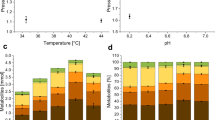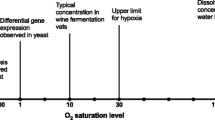Abstract
The yeast Arxula adeninivorans has previously been shown to naturally secrete the redox molecule uric acid (UA). This property suggested that A. adeninivorans may be capable of functioning as the catalyst for a mediator-less yeast-based microbial fuel cell (MFC) if the level of UA it secretes could be increased. We investigated the effects of a number of parameters on the level of UA produced by A. adeninivorans. The concentration of UA accumulated in a dense cell suspension of A. adeninivorans after 20 h incubation was shown to be significantly lower in aerated suspensions compared with that in anaerobic conditions due to UA being rapidly oxidised by dissolved oxygen. The presence of carbon sources, glucose and glycerol, both caused a reduction in UA production compared with that in starvation conditions. The transgenic A. adeninivorans strain, G1221 (auox), showed higher UA production at 37 °C, but at 47 °C, the wild-type LS3 accumulated higher concentrations; however, elevated temperatures also resulted in very high cell mortality rates. An initial buffer pH of 8 caused a higher concentration of UA to accumulate, but high pH is detrimental to cell metabolism and the cells actively work to lower the pH of their environment. It appears that most parameters which increase the amount of UA produced by A. adeninivorans have concomitant disadvantages for cell metabolism, and as such, its potential as a self-mediating MFC catalyst seems doubtful.







Similar content being viewed by others
References
Atkins PW (1997) Physical chemistry, 6th edn. W.H. Freeman and Company, New York
Babanova S, Hubenova Y, Mitov M (2011) Influence of artificial mediators on yeast-based fuel cell performance. J Biosci Bioeng 112(4):379–387
Bond DR, Lovley DR (2003) Electricity production by Geobacter sulfurreducens attached to electrodes. App Environ Microbiol 69(3):1548–1555
Chaudhuri SK, Lovley DR (2003) Electricity generation by direct oxidation of glucose in mediatorless microbial fuel cells. Nat Biotechnol 21(10):1229–1232
Du Z, Li H, Gu T (2007) A state of the art review on microbial fuel cells: a promising technology for wastewater treatment and bioenergy. Biotechnol Adv 25(5):464–482
Eisler H, Fröhlich KU, Heidenreich E (2004) Starvation for an essential amino acid induces apoptosis and oxidative stress in yeast. Exp Cell Res 300(2):345–353
Gienow U, Kunze G, Schauer F, Bode R, Hofemeister J (1990) The yeast genus Trichosporon spec. LS3; molecular characterization of genomic complexity. Zentralbl Mikrobiol 145(1):3–12
Granot D, Levine A, Dor-Hefetz E (2003) Sugar-induced apoptosis in yeast cells. FEMS Yeast Res 4(1):7–13
Gunawardena A, Fernando S, To F (2008) Performance of a yeast-mediated biological fuel cell. Int J of Mol Sci 9(10):1893–1907
Haslett ND (2011) Development of a microbial fuel cell for organic waste bioremediation and simultaneous electricity generation. Lincoln University, Canterbury
Haslett ND, Rawson FJ, Barriëre F, Kunze G, Pasco N, Gooneratne R, Baronian KHR (2011) Characterisation of yeast microbial fuel cell with the yeast Arxula adeninivorans as the biocatalyst. Biosens Bioelectron 26(9):3742–3747
Hubenova Y, Mitov M (2010) Potential application of Candida melibiosica in biofuel cells. Bioelectrochemistry 78(1):57–61
Hubenova YV, Rashkov RS, Buchvarov VD, Arnaudova MH, Babanova SM, Mitov MY (2011) Improvement of yeast-biofuel cell output by electrode modifications. Ind Eng Chem Res 50(2):557–564
Jankowska DA, Trautwein-Schult A, Cordes A, Hoferichter P, Klein C, Bode R, Baronian K, Kunze G (2013) Arxula adeninivorans xanthine oxidoreductase and its application in the production of food with low purine content. J App Microbiol 115(3):796–807
Kannaiah Goud R, Venkata Mohan S (2013) Prolonged applied potential to anode facilitate selective enrichment of bio-electrochemically active Proteobacteria for mediating electron transfer: microbial dynamics and bio-catalytic analysis. Bioresource Technol 137:160–170
Kim HJ, Park HS, Hyun MS, Chang IS, Kim M, Kim BH (2002) A mediator-less microbial fuel cell using a metal reducing bacterium, Shewanella putrefaciens. Enzyme Microb Tech 30(2):145–152
Klabunde J, Kunze G, Gellissen G, Hollenberg CP (2003) Integration of heterologous genes in several yeast species using vectors containing a Hansenula polymorpha-derived rDNA-targeting element. FEMS Yeast Res 4(2 SPEC.ISS):185–193
Lee YY, Kim TG, Cho KS (2016) Enhancement of electricity production in a mediatorless air–cathode microbial fuel cell using Klebsiella sp. IR21. Bioproc Biosyst Eng 39(6):1005–1014
Liu J, Li G, Liu H, Zhou X (1994) Purification and properties of uricase from Candida sp. and its application in uric acid analysis in serum. Appl Biochem Biotechnol 47(1):57–63
Middelhoven WJ, de Jong IM, de Winter M (1991) Arxula adeninivorans, a yeast assimilating many nitrogenous and aromatic compounds. Antonie Van Leeuwenhoek 59:129–137
Myers CR, Myers JM (1992) Localization of cytochromes to the outer membrane of anaerobically grown Shewanella putrefaciens MR-1. J Bacteriol 174(11):3429–3438
Reguera G, McCarthy KD, Mehta T, Nicoll JS, Tuominen MT, Lovley DR (2005) Extracellular electron transfer via microbial nanowires. Nature 435(7045):1098–1101
Reguera G, Nevin KP, Nicoll JS, Covalla SF, Woodard TL, Lovley DR (2006) Biofilm and nanowire production leads to increased current in Geobacter sulfurreducens fuel cells. Appl Environ Microbiol 72(11):7345–7348
Röse H, Kunze G (1998) Integrative transformation of the dimorphic yeast Arxula adeninivorans LS3 based on hygromycin B resistance. Curr Genet 33(2):157–163
Schröder U (2007) Anodic electron transfer mechanisms in microbial fuel cells and their energy efficiency. Phys Chem Chem Phys 9(21):2619–2629
Simic MG, Jovanovic SV (1989) Antioxidation mechanisms of uric acid. J Am Chem Soc 111(15):5778–5782
Steinborn G, Wartmann T, Gellissen G, Kunze G (2007) Construction of an Arxula adeninivorans host-vector system based on trp1 complementation. J Biotechnol 127(3):392–401
Stöckmann C, Palmen TG, Schroer K, Kunze G, Gellissen G, Büchs J (2014) Definition of culture conditions for Arxula adeninivorans, a rational basis for studying heterologous gene expression in this dimorphic yeast. J Ind Microbiol Biot 41(6):965–976
Tanaka A, Ohnishi N, Fukui S (1967) Studies on the formation of vitamins and their function in hydrocarbon fermentation. Production of vitamin B6 by Candida albicans in hydrocarbon medium. J Ferm Technol 45:617–632
Torres CI, Marcus AK, Rittmann BE (2008) Proton transport inside the biofilm limits electrical current generation by anode-respiring bacteria. Biotech Bioeng 100(5):872–881
Verstrepen KJ, Klis FM (2006) Flocculation, adhesion and biofilm formation in yeasts. Mol Microbiol 60(1):5–15
Volkov V (2015) Quantitative description of ion transport via plasma membrane of yeast and small cells. Front Plant Sci 6(425):5–22
Wang X, Cheng S, Feng Y, Merrill MD, Saito T, Logan BE (2009) Use of carbon mesh anodes and the effect of different pretreatment methods on power production in microbial fuel cells. Environ Sci Technol 43(17):6870–6874
Wartmann T, Krüger A, Adler K, Duc BM, Kunze I, Kunze G (1995) Temperature-dependent dimorphism of the yeast Arxula adeninivorans LS3. Antonie Van Leeuwenhoek 68:215–223
Wartmann T, Erdmann J, Kunze I, Kunze G (2000) Morphology-related effects on gene expression and protein accumulation of the yeast Arxula adeninivorans LS3. Arch Microbiol 173(4):253–261
Williams J, Trautwein-Schult A, Jankowska D, Kunze G, Squire MA, Baronian K (2014) Identification of uric acid as the redox molecule secreted by the yeast Arxula adeninivorans. Appl Microl Biot 98(5):2223–2229
Yang XX, Wartmann T, Stoltenburg R, Kunze G (2000) Halotolerance of the yeast Arxula adeninivorans LS3. Antonie Van Leeuwenhoek 77:303–311
Acknowledgements
This work was funded by Science and Innovation, New Zealand Ministry of Business, Innovation and Employment (contract LVLX0802DET) and the University of Canterbury.
Author information
Authors and Affiliations
Corresponding author
Ethics declarations
Conflict of interest
The authors declare that they have no conflicts of interest.
Ethical approval
This study did not involve human or animal subjects and therefore did not require ethical approval.
Rights and permissions
About this article
Cite this article
Williams, J., Trautwein-Schult, A., Kunze, G. et al. Environmental and metabolic parameters affecting the uric acid production of Arxula adeninivorans . Appl Microbiol Biotechnol 101, 4725–4736 (2017). https://doi.org/10.1007/s00253-017-8199-3
Received:
Revised:
Accepted:
Published:
Issue Date:
DOI: https://doi.org/10.1007/s00253-017-8199-3




